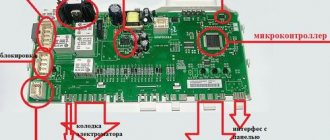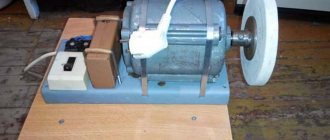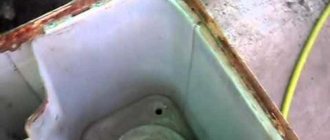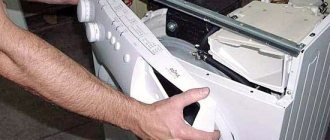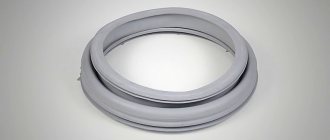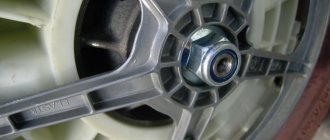There is always a lot of organic waste at the dacha or in the garden: weeds pulled out from the beds, branches remaining after sanitary pruning of trees, grapevines, tops from vegetable crops. Of course, all this can be simply burned, or it can be crushed and put to good use. Ground branches and grass are an excellent base for compost and material for mulching the soil.
A shredder significantly facilitates and speeds up the process of processing organic matter - it is a device powered by a gasoline or electric motor, which drives knives or gears that crush the branches. The principle of its operation is reminiscent of a chopper in a regular food processor - plant waste was loaded into a receiving tank, the machine was turned on, and the knives chopped it up.
Buying a garden shredder in a store is a little expensive, but you can make one from improvised materials. For example, from an old washing machine.
@kakpostroit.su
What do you need to create a herb grinder?
To understand the internal structure of the chopper, decide on its type. The operation of the device can be based on:
- On a gasoline engine. These powerful devices allow you to process large volumes of grass. In addition, it is convenient to work with them anywhere in the garden - a gasoline grass cutter does not need to be connected to the network. The disadvantages include refueling costs and environmental pollution.
- Powered by an electric motor. More compact devices rely on having an outlet nearby. Designed for a smaller volume of production, but a suitable option for households. Productivity depends on the power: 1.5 kW - for branches 2 cm thick, 3-4 kW - 4 cm, and 6 kW - for brushwood and branches.
What does a garden shredder consist of:
- Metal bases.
- Shaft with knives for cutting.
- Engine (can be from an old washing machine).
- Cover for protection.
- Pulley and belt for transmitting torque.
- Box for receiving chopped grass.
- Cable with plug.
Using a grass cutter, you can quickly prepare bales of hay and straw.
For ease of movement, you can equip the device with wheels. A children's bicycle or stroller will do. The remaining components can be found in the garage or shed. You can use a tank from an old semi-automatic washing machine as a basis. It must be metal. What else will you need:
- Motor 180 W or more.
- Cable and plug.
- Start button (can also be removed from the machine).
- Bucket or container for collecting crushed material.
- Steel corners for the base.
- Fasteners.
- Tools: drill, grinder, screwdriver, pliers.
Let's move on to knives. Without them, you won't be able to chop the grass. Grass cutters have several types of knives:
- Disk. Capable of processing grass and small stems.
- Fraser. It will chop even thick brushwood (8 cm).
- Milling-turbine design. It will even process wet thick branches.
To make it yourself, it is better to choose a hacksaw or circular saw. Prepare drawings of the device in advance.
How to make a grass cutter from a washing machine?
Start by preparing your body. If the basis was a washing machine tank, then cut it to the height. You should be comfortable using the device. Prepare a hole (20x7 cm) at the bottom side through which the chopped grass will come out. It should be positioned so that the knives are slightly higher in level.
Secure the casing around the outside of the hole. It will prevent products from flying around and also protect the operator from damage.
A sheet of metal can be used as a casing. Fasten it to the body with self-tapping screws or bolts. The body is ready. Proceed further:
- Make a base from the corners. The height of the legs depends on the height of the container in which the silage will be collected. Secure the base by welding.
- Take measurements of the shaft from the washing machine motor. This is necessary in order to make or order a bushing of the required dimensions. Two holes (7 mm) are drilled in the shaft, exactly the same ones are made in the bushing, after which it is put on the shaft. Secure the structure with bolts.
- Attach the motor to the bottom of the housing using pins.
Prepare your knives. Particular attention should be paid to sharpening. If you are going to work with branches, then sharpen the knife on one side. If with grass, the best option is to sharpen it into a diamond shape.
- The engine shaft is threaded into the hole in the bottom, onto which the knives are placed. Everything is secured from above with nuts.
Important! Calculate the length of the knives so that they do not touch the walls of the container.
- Using a welding machine, secure the tank and engine to the stand.
The structure is ready. All that remains is to install the start button and connect the motor. You will learn how to connect here “How to connect a motor from an old washing machine.”
How does a homemade grass cutter work?
The principle of operation is similar to a regular coffee grinder or meat grinder: you plug the plug into the socket, the engine starts, the shaft begins to rotate, and with it the knives. After throwing the grass into the tank, the knives chop it up, and then it falls into the prepared container.
- Place products in portions, do not overload the machine.
- Do not plant wet branches; the device only works with dry stems.
- Follow safety precautions.
A homemade device can rid the household of waste by turning it into organic fertilizer. Enjoy it for your health!
Safety precautions when working with a chopper and during its manufacture
Since the design of the garden shredder includes piercing and cutting elements driven by a powerful engine, in order to avoid injuries you should follow the safety rules when working with it:
- Before starting work, it is necessary to protect your face, eyes and head from wood chips, which can fly in different directions during the grinding process. This point is especially relevant when processing large branches. To do this, it is recommended to wear special safety glasses, a hat and a mask. You also need to select protective gloves that are sized so that they do not fall off your hands while loading raw materials.
- The garden shredder must be installed on a flat surface to avoid it being thrown over during the working process. It is strictly forbidden to operate electric grass cutters in rainy or windy weather.
- You can push and straighten the branches located in the funnel of the device only with a special pusher, but not with your hands.
- Breaking branches should be of the recommended thickness, which will help avoid equipment breakdown.
- Before loading the grass into the grinder, it is recommended to first sort it out, removing foreign objects from it (stones, metal, glass, plastic, etc.).
- It is recommended to use only fresh branches for crushing. To avoid short circuits, do not use units with a damaged wire or socket, or allow moisture to come into contact with the cable. When refueling a petrol shredder, do not use an open fire near it, or smoke.
- Before cleaning the device, you must wait until all units have completely stopped and disconnect the chopper from the power supply.
A garden shredder is an indispensable and useful thing for gardeners and farmers, which can be easily purchased at markets or made with your own hands. The main thing is to follow safety precautions and properly maintain the unit.
Sources:
https://naogorode.net/izmelchitel-travy-svoimi-rukami/ https://sotka.guru/dachnye-prisposobleniya/izmelchiteli/samodelnyy-izmelchitel-travy-iz-stiralnoy-mashiny.html https://7ogorod.ru /prochee/izmelcitel-travy.html
Do-it-yourself grass and branch chopper - functionality, requirements
The machine is required to quickly cut cut greens and small branches into small pieces. In order not to carry cut plants far, the chopper can be made on wheels for mobility. Loaded branches or leaves must not be blown back out of the tank. The casing prevents small particles from flying in different directions.
To assemble the device with your own hands, you need to consider the availability of parts and the reliability of materials.
The principle of operation of the chopper
A garden waste shredder is somewhat reminiscent of a food processor in operation. It consists of a receiving box, a motor, knives mounted on a shaft, a frame and a box for finished small particles.
Small branches, greens and leaves are lowered into the receiving box. At its bottom there are blades that rotate at high speed due to the operation of the motor. The knives are attached to the operating shaft, which is spun by a motor using a belt (chain) or directly. The ground waste is blown through an outlet pipe or casing into a receiving container.
How the device works
Essentially, a grass cutter is a large blender equipped with knives. The chopper is constructed from a motor, connecting wiring, a container for grass and collecting raw materials, a shaft, knives and a frame.
A popular bookmaker has released a mobile application for Android,
download 1xBet
You can follow the link absolutely free.
In order not to carry the grass to the machine, but to work “on the spot,” the grass cutter is placed on wheels.
Operating principle: the engine transmits rotation to a shaft with knives that chop the grass. The raw materials are transported to a container for chopped greens, from where the mass is removed into compost pits.
Components of the structure
It’s not difficult to assemble a DIY herb chopper from a washing machine. Many of the parts are available at home; the missing parts can be purchased. Such homemade products are indispensable in the household.
Electric motor
Minimum requirements for the motor: power 180 W and engine speed in the range of 1350-1450 rpm. The greater the power and speed, the greater the volume of waste that can be processed. Motors from a modern washing machine are more difficult to use, since they are controlled electronically. It is better to take an engine from the Oka, Fairy or Malyutka car models. The greater the engine power, the thicker the branches it will be able to cut.
The receiving box must be durable. Stones or wires caught inside may damage the housing. It is better to choose a cylindrical tank shape. The tank can be made from a large metal bucket or barrel, additionally strengthened with a sheet of iron. You can use a washing machine tub. If it is very tall, it can be easily shortened with an angle grinder. When the blades rotate too quickly and the grass flies out of the box, it is equipped with a lid.
At the bottom of the tank, at the level of the blades, there is a hole for pouring out crushed particles. A steel angle can be welded or bolted to the bottom of the tank in front of the hole to drain crushed particles.
There can be one or several blades in a grass cutter. This is usually a rectangular metal plate, sharpened on one side, attached to the motor or shaft. There may be several plates. Disc-shaped knives are also used. The size depends on the desired size of the cut. You can make your own blades from a hacksaw blade or an old saw, or use lawn mower blades.
The size of the knives should be such that they do not touch the walls of the tank. But you don’t need to make a long distance so that the grass doesn’t get wrapped up.
Tools and materials for making grass cutters
The master will need:
- grinder or angle grinder;
- drill with a set of drills;
- welding machine;
- winding testing device;
- Screwdriver Set;
- hammer;
- bolts with nuts and washers;
- a set of open-end wrenches or pliers;
- washing machine tank;
- motor with a power of 180 W;
- knives;
- electrical cable and plug;
- container for collecting cut raw materials;
- metal sheet for the casing;
- metal corners;
- control buttons (on/off).
When performing work, the master will not be hindered by personal protective equipment.
List of assembly tools
To assemble a branch chopper from a washing machine yourself, you will need the following tools:
- Electric drill.
- Bulgarian.
- Multimeter (tester).
- Screwdriver Set.
- Hammer.
- Bolts, studs, washers.
- Pliers.
- Welding machine (if you make the frame yourself).
- Insulating tape.
Safety
It is necessary to observe safety precautions both when assembling the grass cutter and when working with it, making sure that no exposed wires are left during assembly. It is important to wear safety glasses or cover the tank while the shredder is operating.
Gardening work involves the use of various devices and tools. Some you can do yourself. For example, crushed weeds and twigs are added to prepare good compost or fertilizer. Pulling grass by hand is time-consuming and difficult; it’s easier to do it in a shredder.
How to make a grass and twig chopper for your garden with your own hands
About the Bosch garden shredder - operating principle, best models
All about garden shredders - types of shredders for branches and grass
Attachment for chopping branches on a walk-behind tractor - what is it, characteristics
All about the Zubr garden shredder - operating principle, how to use
Makita UD2500 - parameters and description of a branch chopper for the garden
The nuances of operating homemade equipment
Any homemade product is not always equipped with all the devices according to safety requirements. During operation, in order to avoid accidents, the following rules must be observed:
- When starting work, you should use tight-fitting gloves, glasses and a hat; It is strictly forbidden to push branches and debris with your hands; for this you can use the next batch of tops.
- The diameter of the material to be crushed must not exceed that allowed by the engine power; Do not allow hard materials to enter the cutting blade hopper; they can damage the blades and damage the engine.
- If branches get stuck in the drum, the unit is completely de-energized, and only then are the stuck pieces removed.
- The power wires are laid in places where branches will not lie and wood chips will not fall.
Correct and long-term use of a hand-made branch chopper is possible not only if operating conditions are observed, but also with proper storage. After chopping, the knives are cleaned, and the device itself is put away in a shed or under a shed, and the knives are sharpened if necessary. Almost anyone can build a branch crusher with their own hands, the main thing is to have an engine and the necessary metal blanks.
Operating principle and device of the grass cutter
If we compare grass shredders with other agricultural equipment, they are quite popular among gardeners. A wide range of products allows both professionals and amateurs to purchase equipment according to their needs and financial capabilities. The range includes compact household appliances and professional equipment designed for processing raw materials in large quantities. A simple grass cutter includes:
- Working shaft with cutting knives.
- Container for raw materials.
- Protective shell.
- Electric or gasoline motor, cable and pulley with belt.
- Steel frame.
The device works on a simple principle: the raw material is placed in a container with knives, where it is ground into a crushed mass. The operation of the device is similar to a working food processor. The volume of raw materials becomes smaller, which makes it possible to add it to the feed mixture or use it for mulch. For small volumes, raw materials are loaded into the container manually.
Herb grinder from washing machine
Adhering to design features , you can make a grass cutter from a washing machine with your own hands. For assembly you will need:
- 180 Watt tank and motor. There is such a motor in a washing machine. In order for the device to be able to process not only grass, but also large branches, a powerful engine is needed. The greater its power, the better.
- Disc knife.
- Electrical cable with plug.
- Start button.
- Container for raw materials.
- Steel corner.
- Connecting elements: bolts, bushings and washers.
A gasoline engine has more power than a washing machine engine. By installing it in the device, you will get a “three in one” device that, together with grass and straw, can process branches over 5 mm thick.
Assembling the apparatus
First, we assemble the upper container for processing raw materials. For this:
- We take and cut the body of the washing machine to height. This will create additional convenience when operating the equipment.
- In the lower part of the body, at the same level with the legs or slightly higher, we make a hole (20x7 cm) of a rectangular shape.
- To prevent the grass from scattering in different directions, the hole is covered with a casing. The casing is made of a metal plate and secured with bolts.
- Then prepare the stand. Here you will need a welding machine and a metal corner. Depending on the size of the container in which the raw materials will be located, the height of the stand is calculated. A tall support is made for a bucket; a low stand is suitable for a basin.
- Two holes with a diameter of 7 mm are made on the motor shaft. They order from a turner or make on a lathe a bushing about 50 mm long, which is put on the motor shaft. The finished part is secured with studs on the underside of the tank.
- The cut and sharpened knives are put on the shaft so that they do not touch the walls of the container. The knives are securely fixed with plumbing nuts (32 mm).
- A welding machine is used to weld the container with the motor to the stand.
- The tester determines the starting and operating windings of the motor . Less resistance indicates that this is a working winding. Having correctly identified the contacts, the motor is connected to the electrical cable.
- The connection is made as follows: on the one hand, the starting winding is connected to the starting button wiring, and on the other hand, it is connected to the working winding and cable. The second side of the working winding is connected to the start button and cable.
Features of work
The chopper works on the principle of a food processor. The device consists of several elements:
- two containers for cutting and collecting grass;
- motor and connecting wiring;
- steel frame and cover;
- shaft with knives.
To move the grass cutter comfortably, it can be equipped with wheels. The shaft receives rotational motion from an electric motor, and the grass, taking into account the movement of the device, enters the cutting tank. The chopped plants go into a container for collection.
Operating rules
When working with any electrical device, safety precautions must be observed. The grass cutter is no exception! To prevent the device from deteriorating, you need to know the basic operating rules:
- The mechanism will jam if damp branches or grass are placed in the device.
- You cannot store raw materials in large quantities. Everything should be in moderation.
- The device must always be supervised .
- The mechanism has piercing and cutting elements, so children should not be allowed near the device.
- To prevent the device from getting wet in the rain, it is installed under a canopy.
- Do not allow foreign objects such as glass or metal to get inside the device.
- If something is stuck inside, the device is disconnected from the network and only then the stuck part is removed.
- Electrical wires must be insulated.
The first launch of the device is done very carefully, since it is the most dangerous.
How does a grass cutter from a washing machine work?
Grass is loaded into the connected grass cutter, just do not fill the tank full at once. A container for chopped silage is placed, and the device is connected to the network.
Be sure to follow safety precautions when working with the shredder. Try not to load wet branches, otherwise the device will jam. In the future, it is enough to sharpen the knives for the grass cutter to work properly.
Grass cutters are easy to make and also easy to care for. Therefore, if you have an old washing machine, you can put it to good use.
Design Features
A grass cutter is a special device for chopping grass, which is indispensable in a farmstead.
Once grass clippings are processed, they can be used as soil fertilizer, insulation material in winter, or pet food.
This tool can finely chop a large volume of weeds or grass clippings in just a few seconds. This is a significant saving of time and effort for the owner of a personal plot.
The design of a standard manual grass cutter includes the following parts:
- steel frame;
- electric motor;
- cutting knives;
- working shaft;
- pulley;
- belt;
- container for receiving grass;
- protective casing;
- cable.
Homemade garden grass cutters are compact in size and light in weight, which makes them much easier to use.
At the same time, they have good performance. The unit can be equipped with both a gasoline and an electric motor:
- A gasoline engine is a more powerful device that allows you to chop branches of bushes. Its main advantage is the ability to operate even in areas where there is no electricity. Disadvantages: heavy weight, noisy operation.
- The electric motor is not as powerful as a gasoline engine, but is lighter and more convenient to use. This device is started with one turn of the toggle switch. Its main disadvantages are its dependence on the power grid and the limitation on the thickness of the stems of the processed vegetation.
Grass cutter with electric motor
A DIY electric grass cutter is a useful tool for your own garden plot.
With its help, it is convenient to prepare animal feed from grass and small twigs, especially from nettle, which is considered very useful for livestock.
Types of engines
A homemade branch chopper has one basic design. The difference may be in the power of the electric motor. For more powerful devices, a gasoline engine is used; it can be used to chop trees with trunks with a diameter of more than 100 mm. Gasoline cars are distinguished by their mobility due to their independence and independence from power sources.
Electric drives for garden wood chippers are divided into three main types based on power:
- To process waste in small areas, an engine with an operating power of up to 1.5 kW is used; it is capable of grinding branches with a diameter of up to 2 cm.
- When chopping branches up to 4 cm, a drive with a power of up to 4 kW is used on a personal plot.
- A value of 6 kW or more is used when working on wood waste collection in large areas.
Basically, when making a branch chopper with your own hands, install an electric motor of no more than 4 kW. A power value higher than this may result in high energy consumption. The speed from the drive can be 1500 rpm; to adjust this indicator, you can change the diameter of the pulley.
Torque is transmitted using a chain or belt drive, or by installing shredder blades on the engine shaft itself.
DIY grass cutter
From a gas cylinder
Instructions:
- From a gas cylinder we cut out ring 1 of the required size, and from a steel sheet 3 mm thick - a cover 2 of slightly larger diameter (Fig. 1)
. We press them together with clamps and weld them from the inside. We clean the outer protrusions of the resulting casing with emery. - On a lathe we make a hole 4 in the cover for the knife shaft 6 and make markings for the clamp 3.
- We cut out a ring for the clamp from the pipe, weld the jaws to it, drill a through hole d 7 mm in them for bolt 7. Then we cut the ring between the jaws and, installing the clamp on the grinder, insert a metal spacer between them. We clamp the bolt, allowing the clamp to move freely along the angle grinder. Then we weld the clamp to the circle (according to the markings), leaving 1/3 of the circle free near the jaws.
- pipe 5
onto the casing of the grass cutter , cut out a hole inside using electric welding, and clean the edges with a grinder. - We make the knife from a saw blade, sharpen it, burn a hole by welding (we don’t recommend drilling, it will ruin a lot of drills) and expand it with emery attachments (Fig. 2)
. We install it with the cutting edges up. - We put the finished casing with a knife on the electric motor shaft.
Blueprints:
From the Bulgarian
Today, almost everyone on the farm has a power tool like a grinder. This is an ideal option for making a manual herb grinder.
In addition to the grinder, you will need the following tools and parts:
- hammer;
- screwdriver;
- engine;
- steel brackets, bolts and nuts;
- shaft;
- frame;
- cutting discs or blades;
- pulleys;
- net;
- container for chopped grass.
First of all, you need to securely fasten the engine; for this we take metal corners and make a frame from them. Next, you should attach the grinder to this frame as firmly as possible, since it operates at very high speeds and if it comes off, it can cause trouble.
Then a metal container is installed on top of the grinder shaft (it is located upwards), grass will be loaded into it and, in fact, the cutting process will take place in it.
It is best that the steel of the container be as thick as possible, otherwise, if the knife suddenly unscrews while the grass cutter is working, it may pierce the steel and fly out.
A steel corner is attached to the bottom of the container; it is needed to keep the entire herbal mass from scrolling inside the container. The corner is secured with bolts and nuts.
Now you just need to install the lawn mower blade on the grinder shaft.
For convenient collection of chopped grass, a special sleeve was made from thin metal; it can be directed into a special box for collecting grass flour or simply placed in a bucket. At this point, the assembly of the grass cutter can be considered complete.
From the washing machine
Let's look at another way to create a grass cutter from scrap materials.
From the materials we will need:
- electric motor from a washing machine;
- housing from the Uralets vacuum cleaner;
- durable sheet metal for creating a knife;
- plastic bucket or other container to create a bunker;
- plastic bucket to create a grass catcher;
- steel corners;
- electric welding;
- Bulgarian;
- drill;
- screws with nuts and more.
Step-by-step instructions for making the tool:
- Preparing the body. According to the diagram, the body is taken from a vacuum cleaner, at the bottom of which a 70x70 cm hole is made to dump crushed raw materials.
- Electric motor installation. The unit is installed on the bottom of the product body with the shaft up. The motor itself is taken from a washing machine. The knife is cut from sheet iron using a grinder. Its edges are raised slightly upward.
- Bunker and grass catcher. These two containers are made from plastic buckets. They are lightweight and the material does not rust, which is very important in this case. A bag is placed on top of the catcher for the finished chopped greens so that they do not fly away in different directions during the cutting process.
- Tool frame. This is an important structural element on which all other parts are fixed. For its manufacture, strong metal corners are used, which are connected to each other using a welding machine.
At this point, the assembly of the tool can be considered complete. With its help, cutting food from weeds, grass and small branches for animals will be done quite quickly.
From a drill
An excellent grass cutter can be very easily built from a regular drill. Exactly how this simple device works can be seen in the video below:
So, the grinding process resembles the work of a food processor: in a cylindrical body, the role of which is played by a simple bucket, there is a sharply sharpened knife.
When it rotates in a circle at high speed, the grass is cut. To make this grass cutter, a two-mode Temp drill with a power of 850 watts is used. The knife is made of hacksaw blade. The whole secret is hidden in sharpening the knife.
If done correctly, the grass will not wrap around the blade. The knife should remain clean and free of greens. Sharpen the knife with a one-sided sharpening.
It should be oriented with the sharpened plane facing down. If you have to chop fresh grass, the best shape of the knife would be a narrow diamond so that the cutting edge disappears at an angle to the edges.
As a last resort, you can round the blade towards the tip.
Then the grass, which is affected by centrifugal force, slides along the cutting edge of the knife straight to the edges. It cuts easily and never wraps around the knife.
Homemade straw cutter
Three previous units successfully turned grass into silage. But if we need a chopper not only for grass, but also for hay, it’s worth taking a closer look at another invention, which is presented in great detail in the video below.
Manual chopping
A small volume of raw materials can be crushed using a manual metal chop, placed on a long handle.
The cut is a sharply sharpened triangular plate, the longest side of which is directed downwards.
Freshly cut grass, weeds, leaves, tops are laid out on the ground in a layer of 10-15 cm and chopped into pieces. The tool must be lowered sharply. After each blow, the plant mass is divided into smaller and smaller parts.
Manufacturing recommendations
Making a grass cutter with your own hands is quite often described in the magazine “Modelist-Konstruktor”. You can find many options for such tools here.
All recommendations are supported by diagrams, design and assembly drawings of devices.
The operating principle of many models is similar to that of a food processor, since the cutting of greens is carried out using knives. This explains the ease of assembly and ease of operation of the grass cutter.
For more efficient operation of the tool, experts recommend:
- To chop bush branches, use knives sharpened on one side.
- To grind feed, animals need to take knives sharpened on both sides.
- If you plan to use the tool only for chopping grass, it is recommended to make diamond-shaped knives.
- To increase the strength and reliability of the device, it is worth using a metal case.
- It is recommended to sheathe the outer sides of the instrument with sheet iron. This will significantly reduce the likelihood of injury during operation and protect the unit’s engine from dust.
The main advantage of homemade devices designed for cutting grass is that they are low maintenance.
You can always repair them yourself using available materials, and repair costs are minimal.
